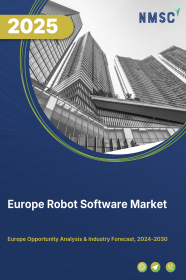
Europe Robot Software Market by Software Type (Recognition Software, Simulation Software, Predictive Maintenance Software, Communication Management Software, and Data Management and Analysis Software), by Robot Type (Service Robots and Industrial Robots), by Deployment Mode (On-premise and On-demand), by Organization Size (Large Enterprises and Small and Medium-sized Enterprises (SMEs) – Opportunity Analysis and Industry Forecast, 2024–2030
Industry: ICT & Media | Publish Date: 14-Feb-2025 | No of Pages: 227 | No. of Tables: 153 | No. of Figures: 118 | Format: PDF | Report Code : IC2378
Europe Robot Software Market Overview
The Europe Robot Software Market size was valued at USD 2.53 billion in 2023, and is expected to reach USD 11.61 billion by 2030, with a CAGR of 23.3% from 2024 to 2030. Robot software comprises a suite of programs and algorithms crafted to supervise and manage the operations of robots or robotic systems in various industries such as logistics, manufacturing, entertainment, healthcare, and more. Its functionality encompasses several crucial components. Firstly, it coordinates and manages the movements and behaviors of robots, ensuring precise and efficient task execution by issuing detailed commands to robotic components such as motors and actuators.
Additionally, robot software plays a critical role in interpreting data from various sensors embedded within robots, including cameras, Light Detection and Ranging (LIDAR) sensors, and tactile sensors. This data interpretation provides essential environmental feedback that enables robots to accurately perceive and understand their surroundings. An integral aspect of robot software is its ability to make intelligent decisions using artificial intelligence (AI) and machine learning (ML) algorithms.
Through the analysis of data from sensors, adherence to predefined rules, or learning from past experiences, robots can adapt to changing conditions, allowing them to operate autonomously and adjust their actions in real-time. Furthermore, robot software facilitates communication and networking among robots, enabling collaboration for complex tasks or data exchange with a central control system. This interconnectedness facilitates synchronized operations in industrial environments, leading to enhanced efficiency and productivity.
Rising Labor Costs and Workforce Challenges Drive the Europe Robot Software Market Growth
The surge in labor costs and persistent workforce challenges are key drivers propelling the growth of the robot software market in the region. With labor expenses on the rise, particularly in industries heavily reliant on labor-intensive tasks, organizations are actively seeking solutions to minimize costs while sustaining productivity levels.
This trend encourages widespread adoption of automation technologies, including robots, aimed at streamlining operations and reducing dependency on human labor. At the core of this shift lies the essential role played by robot software, facilitating efficient programming, management, and optimization of robotic systems.
Furthermore, workforce challenges such as skill shortages and demographic shifts act as additional incentives for businesses to invest in robot software solutions, ensuring seamless operations and competitiveness. Consequently, the Europe robot software market witnesses sustained growth as organizations increasingly turn to automation to address labor-related challenges and enhance operational efficiency.
Increasing Investments in Research and Development (R&D) Drive the Growth of the Europe Robot Software Market Trends
Increasing investments in research and development (R&D) play a crucial role in driving the growth of the robot software market in the region. As organizations and governments allocate more resources to R&D initiatives, there is a heightened focus on advancing robotics and automation technologies, including robot software.
These investments serve as catalysts for innovation, leading to the development of more sophisticated and capable robot software solutions. R&D efforts significantly contribute to enhancing functionalities such as AI integration, machine learning algorithms, and advanced control systems, enabling robots to perform complex tasks with greater efficiency and autonomy.
Moreover, R&D investments fuel the exploration of new applications and use cases for robot software across diverse industries, expanding the market's potential. By fostering technological advancements and addressing emerging challenges, increased R&D investments stimulate market growth and drive the evolution of the robot software market.
High Initial Investment for Acquiring Robot Hardware Restrain the Growth of the Europe Robot Software Market
The significant upfront investment needed to procure robot hardware represents a notable barrier to market expansion in the region. Acquiring robot hardware involves substantial initial costs, encompassing the purchase of robotic systems, peripherals, and related equipment.
These expenditures can be prohibitive for numerous organizations, particularly small and medium-sized enterprises (SMEs) or those with limited financial resources. The substantial financial commitment required for robot hardware may dissuade potential adopters from investing in robot software solutions, despite recognizing their potential long-term benefits.
Furthermore, the high initial investment may prolong the return on investment (ROI) period, resulting in longer payback periods and limiting the scalability of robot deployments. Consequently, addressing the issue of high initial investment costs for robot hardware is critical to unlocking broader adoption and fostering growth in the Europe robot software market.
The Expansion of Robotics-as-a-Service Creates New Opportunities in the Europe Robot Software Market
The expansion of Robotics-as-a-Service (RaaS) introduces fresh opportunities in the market by providing a more accessible and cost-effective pathway for organizations to implement robotics solutions in the region. RaaS models enable businesses to access robotic hardware, software, and related services through subscription plans, eliminating the need for significant upfront investments in capital-intensive assets.
This approach diminishes entry barriers, particularly for small and medium-sized enterprises (SMEs) or entities with limited budgets, enabling them to leverage robotics technology without the financial constraints of ownership. Additionally, RaaS models often include maintenance, support, and software updates within the subscription, delivering added value and simplifying the deployment process.
By democratizing access to robotics technology and fostering a pay-as-you-go model, the expansion of RaaS unlocks new market opportunities, driving adoption across diverse industries and catalyzing innovation in robot software solutions.
Germany Holds Dominant Share in Europe Robot Software Market
Germany dominates the Europe robot software market share for several reasons. Firstly, Germany is renowned for its strong manufacturing sector and industrial prowess, with robust industries such as automotive, engineering, and machinery.
This foundation creates a substantial demand for robotics and automation solutions, including robot software. Additionally, German companies are leaders in innovation and technology adoption, continuously seeking ways to improve productivity and efficiency through automation.
Furthermore, Germany benefits from a highly skilled workforce, advanced infrastructure, and supportive government policies that incentivize investment in automation and Industry 4.0 initiatives. The region's strategic position as a central hub in Europe further enhances its dominance in the regional market. Overall, Germany's combination of industrial strength, technological expertise, and supportive ecosystem solidifies its position as a leader in the Europe market for robot software.
Sweden is Expected to Show Steady Rise in Europe Robot Software Market
Sweden is expected to show a steady rise in the market due to several key factors. Firstly, Sweden boasts a strong tradition of innovation and technological advancement, particularly in the fields of engineering and robotics.
This heritage, coupled with a highly skilled workforce and supportive government policies, positions Sweden as a leading player in the development and adoption of robotics and automation technologies. Additionally, Sweden's commitment to sustainability and green initiatives drives investment in advanced manufacturing practices, including the use of robotics to improve efficiency and reduce environmental impact.
Moreover, collaborations between academia, industry, and government foster innovation and drive the adoption of robot software solutions across various sectors. Overall, Sweden's combination of technological expertise, favorable business environment, and focus on sustainability make it well-positioned for a steady rise in the Europe market for robot software.
Competitive Landscape
Several key players operating in the Europe robot software industry include IBM, NVIDIA, ABB Ltd., FANUC, Teradyne, Inc., H2O.ai, Brain Corp, CloudMinds, Clearpath Robotics, and Neurala, Inc. These market players are adopting strategies to maintain their dominance in the market.
Europe Robot Software Market Key Segments
By Software Type
-
Recognition Software
-
Simulation Software
-
Predictive Maintenance Software
-
Communication Management Software
-
Data Management and Analysis Software
By Robot Type
-
Service Robots
-
Ground
-
Aerial
-
Underwater
-
-
Industrial Robots
-
Traditional Industrial Robots
-
Articulated Robots
-
SCARA Robots
-
Parallel Robots
-
Cartesian Robots
-
Other Robots
-
-
Collaborative Industrial Robots
-
By Deployment Mode
-
On-premise
-
On-demand
By Organization Size
-
Large Enterprises
-
Small and Medium-sized Enterprises (SMEs)
By Industry Vertical
-
Banking, Financial Services, and Insurance (BFSI)
-
Automotive
-
Retail and eCommerce
-
Aerospace & Defense
-
Healthcare and Life Sciences
-
Transportation and Logistics
-
Manufacturing
-
Telecommunications and IT
-
Academia and Research
-
Media & Entertainment
-
Others
By Country
-
The U.K.
-
Germany
-
France
-
Spain
-
Italy
-
Netherlands
-
Denmark
-
Finland
-
Norway
-
Sweden
-
Russia
-
Rest of Europe
REPORT SCOPE AND SEGMENTATION:
|
Parameters |
Details |
|
Market Size in 2023 |
USD 2.53 Billion |
|
Revenue Forecast in 2030 |
USD 11.61 Billion |
|
Growth Rate |
CAGR of 23.3% from 2024 to 2030 |
|
Analysis Period |
2023–2030 |
|
Base Year Considered |
2023 |
|
Forecast Period |
2024–2030 |
|
Market Size Estimation |
Billion (USD) |
|
Growth Factors |
|
|
Countries Covered |
12 |
|
Companies Profiled |
10 |
|
Market Share |
Available for 10 companies |
|
Customization Scope |
Free customization (equivalent up to 80 working hours of analysts) after purchase. Addition or alteration to region, regional, and segment scope. |
|
Pricing and Purchase Options |
Avail customized purchase options to meet your exact research needs. |
KEY PLAYERS
-
IBM
-
NVIDIA
-
ABB Ltd.
-
FANUC
-
Teradyne, Inc.
-
H2O.ai
-
Brain Corp
-
CloudMinds
-
Clearpath Robotics
-
Neurala, Inc.

















 Speak to Our Analyst
Speak to Our Analyst





















